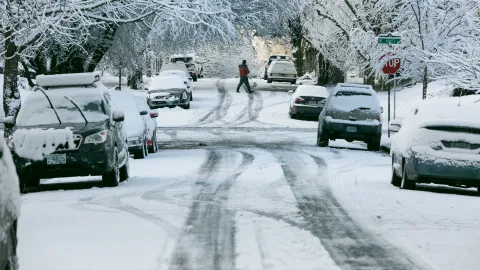Take public transit
You moved to Oregon with a dozen pairs of flip flops, but no boots in your bag. You never learned to attach snow chains to your Honda Fit. When it snows, have no fear. TriMet is here.
MAX and bus drivers hit the road even when the weather is bad. Just remember these few tips before you ride:

- Check for service alerts
- Know your bus line’s snow route
- Bundle up and be visible
- Expect delays and be kind.
Check the roads
Oregon Roads: The Oregon Department of Transportation TripCheck site updates road conditions and streams live roadside video.
Trip Planner: The Federal Department of Transportation teamed up with the National Weather Service to create a trip planning site, coupling road conditions with weather patterns.
Drive safe
Chain up. Learn to put on snow chains, and carry flares and a tarp for dark or wet conditions.
Slow down. Speed is the number one reason for accidents. While three to five seconds is the standard following distance, add more time for poor visibility, snow or ice.
Pack a Kit. When the car breaks down, it’s safest to stay with it until help comes. Here some common items to consider keeping in a car emergency kit:
- Kitty litter or road salt
- Chains and a tarp
- Jumper cables
- Flairs and a safety triangle
- Proper footwear
- Sleeping bags or blankets
- First aid supplies
- Toilet paper
- Water
- Medications
- Granola bars and snacks
Where’s the plow?
See Multnomah County’s snow-plow priority routes and find links to area city routes and resources.
Visit the City of Portland’s winter weather center to track the city’s 56 snow plows. The city uses salt, sand and gravel to clean major roads during snow and ice. This site also flags road closures and weather cams!
Check the City of Gresham’s snow and ice map to find priority routes for deicing and snow plowing.
Landslides and Trails
Hiking on unstable ground and loose dirt can be dangerous during or immediately following heavy rains. The 2017 Eagle Creek fire burned vegetation that holds dirt in place along steep slopes in the Columbia River Gorge.
Visit the U.S. Forest Service for information about closed trails and risks in the Columbia River Gorge National Scenic Area.
